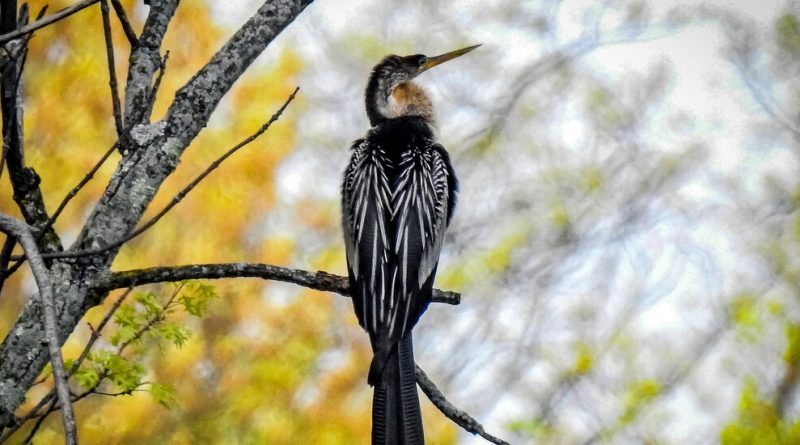The Anhinga or ‘Devil Bird’ Lands in New York, With More to Come
[ad_1]
For two weeks, a strange bird has perched in Brooklyn over the treetops of one of the Three Sisters Islands in Prospect Park Lake. It shows no signs of heading back to the place it most likely came from in the South.
Meet the anhinga, a large water bird with a snaky neck that has joined other high-profile vagrant birds in recent years by making a rare appearance outside of its typical migration range.
The bird’s name comes from the Tupi Indian language of Brazil and means “devil bird.” And according to the Cornell Lab of Ornithology, it’s not from around here: Anhingas in the United States generally range from the Southern states along the gulf coast to Texas, stretching into the Carolinas in the summer.
The Prospect Park anhinga is the first devil bird observed in Kings County, and only the second sighting in New York City since 1992. When Radka Osickova first spotted it with the Brooklyn Bird Club, she couldn’t believe her eyes.
“What kind of a weird heron is that over there?” she recalls asking.
Researchers say that this rogue anhinga didn’t merely veer off course, but that it was taking advantage of a habitat that was newly available to it because of rising temperatures.
“What we are seeing here is likely an expanding population from the previous typical range of the species in the southeastern United States,” said Andrew Farnsworth, a researcher at the Cornell lab. He added that the anhinga “is a strong flier and quite a migrant, so it’s not necessarily a surprise this is happening.”
Longtime bird-watchers have noted other unusual feathered visitors in Prospect Park in recent months.
“Some of the species include summer tanager, yellow-throated warbler, Acadian flycatcher (now nesting in the park) and others,” said Tom Stephenson, a Brooklyn birder, in an email. “We’ve also seen a number of unusual Western species in Brooklyn, including Townsend’s warbler and Swainson’s hawk.”
Kenn Kaufman, a bird expert and field guide author, says we’re seeing a broad pattern emerging with Southern birds in search of new nesting territories.
“In evolutionary terms, these far-flung wanderers might be viewed as testing the limits,” Mr. Kaufman said.
The anhinga in Brooklyn may be on its own, but there were earlier indications that the species had been making forays much farther north. Days before the sighting in Brooklyn, Timothy Wing spotted another anhinga outside his car window in Rome, N.Y., about 180 miles north of New York City.
“Out of the corner of my eye, I saw what I assumed was a double-crested cormorant sitting on a log in the canal on my left,” said Mr. Wing, a bird enthusiast. “The color for the head and neck was much lighter than a typical cormorant, and it didn’t seem right.”
He pulled over and took a closer look with a spare set of binoculars he keeps in his car.
“To my amazement, I saw multiple anhingas sitting on a log, and many others up in the trees along the opposite bank of the canal,” he said.
After taking photos with his cellphone, Mr. Wing confirmed his sighting with a friend. They counted 22 anhingas and logged them into eBird, the online bird observation database.
“It was truly an incredible sight to behold,” he said.
Mr. Kaufman shares Mr. Wing’s enthusiasm for the rare encounter, while noting the growing number of anhingas seen in the Middle Atlantic States.
“Viewed in isolation, the flock upstate seems utterly astounding,” Mr. Kaufman said. “And it is, in the context of New York State records.”
Since the initial sighting in Brooklyn, throngs of delighted birders have visited Prospect Park hoping to catch a peek.
“While we’re excited to see the anhinga to N.Y.C., please watch from a distance and respect its space,” said Sarah Aucoin, the chief of education and wildlife for the New York City parks department. “It may not be from around here, but it’s still a wild animal for us to respect.”
